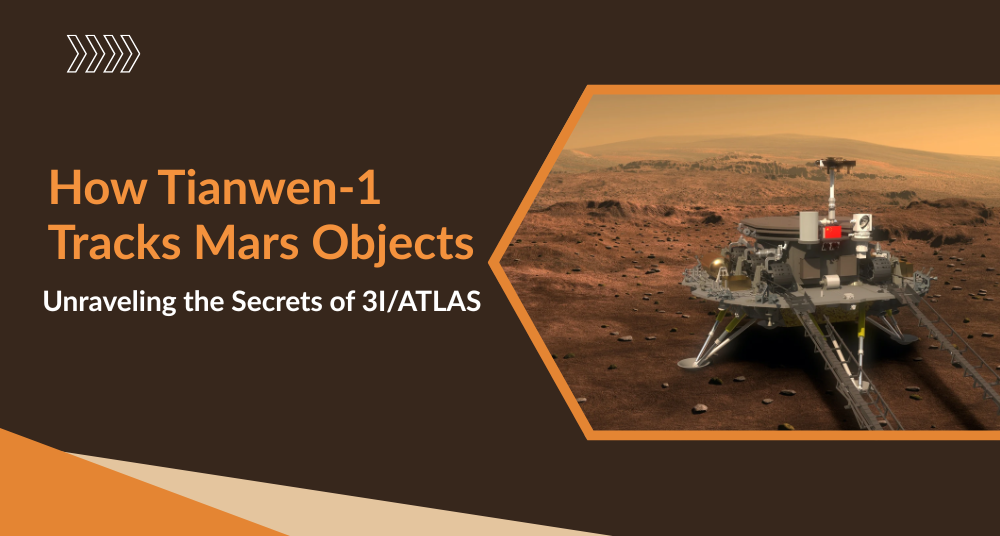The vastness of space continues to challenge our understanding of the universe, and few objects have captured the imagination of scientists and enthusiasts alike as much as 3I/ATLAS. This interstellar object, first detected entering our solar system, has displayed strange and unprecedented behavior that has puzzled astronomers across the globe. Recently, images captured by the R. Naves Observatory in Spain on November 5 have revealed that 3I/ATLAS shows no visible cometary tail, a discovery that has raised further questions about its nature. Meanwhile, China’s Tianwen-1 Mars Orbiter continues to provide critical observations, demonstrating the sophistication of modern interplanetary tracking technologies.
3I/ATLAS: The Interstellar Enigma
Comets entering the inner solar system typically display bright tails and comas as they approach the Sun. This activity is caused by the sublimation of ice and the release of dust and gas, forming the characteristic cometary structure that points away from the Sun. However, 3I/ATLAS defies these expectations. Observations from November 5 show a compact source of light without any visible tail, marking one of the few images captured post-perihelion at the end of October.
Harvard astrophysicist Avi Loeb noted the unusual characteristics of 3I/ATLAS, emphasizing that the object’s behavior near the Sun is highly unorthodox. Based on non-gravitational acceleration observed during perihelion, the comet should have lost a significant fraction of its mass—roughly 5 billion tons of dust and gas—which would have formed a noticeable coma and tail. Yet, the images suggest otherwise, leaving astronomers questioning the physical processes driving this object’s motion and appearance.
Unprecedented Anomalies
Loeb has identified a series of anomalies associated with 3I/ATLAS, now numbering ten in total. One of the most striking observations is the absence of a cometary tail despite the significant mass loss predicted by models of perihelion behavior. For comparison, typical comets, such as Comet Lemmon, exhibit a clear tail extending away from the Sun, shaped by solar radiation and solar wind. In contrast, 3I/ATLAS has remained compact and blue in color, a stark deviation from conventional cometary physics.
Another anomaly is the color change near the Sun, where 3I/ATLAS appears bright blue instead of the usual red or orange hue. Earlier observations also noted a lack of tail, and a faint tail was only briefly captured in September by the Gemini Multi-Object Spectrograph (GMOS) on Gemini South at Cerro Pachón in Chile. During July and August, it exhibited a sunward jet (anti-tail), further adding to its list of unusual behaviors.
These phenomena have not gone unnoticed by the global scientific community. Researchers are carefully monitoring the object using multiple observatories, but much remains unexplained, prompting some scientists to call for more detailed observations and spacecraft missions to study interstellar comets.
The Role of Tianwen-1
While 3I/ATLAS has been observed from Earth, spacecraft like China’s Tianwen-1 Mars Orbiter have showcased the capabilities of modern space tracking systems. Tianwen-1 is primarily designed for Mars exploration, but its advanced orbital sensors and imaging technology can track objects across the solar system. The orbiter provides high-resolution images, precise measurements, and orbital data that allow scientists to monitor celestial objects with remarkable accuracy.
Tracking an object like 3I/ATLAS requires sophisticated algorithms that predict the object’s trajectory, calculate non-gravitational forces, and compensate for observational constraints such as distance, angle, and light interference. Tianwen-1’s observations complement ground-based telescopes, enabling cross-verification of images and data for a more comprehensive understanding of the object.
NASA’s Role and Public Curiosity
The mystery surrounding 3I/ATLAS has been further compounded by limited data releases from NASA. Images captured by the Mars Reconnaissance Orbiter on October 2-3 have not yet been publicly released, fueling speculation and misinformation across social media and news platforms. WION has reported on unverified photos and videos circulating online, highlighting the need for careful scientific communication.
Despite these challenges, the scientific community remains committed to uncovering the truth. Observatories in Spain, Chile, and other locations continue to monitor 3I/ATLAS, ensuring that anomalies such as the missing tail, blue color, and non-gravitational acceleration are accurately documented. These observations are crucial for understanding not only the physics of interstellar comets but also the broader dynamics of solar system interactions.
Implications for Future Research
The strange behavior of 3I/ATLAS raises several scientific questions:
- Mass Loss Mechanics: How can the object exhibit non-gravitational acceleration without forming a tail?
- Composition and Structure: Does its internal structure differ significantly from typical comets, preventing dust and gas from forming a visible coma?
- Color Variation: What causes the abrupt shift to a bright blue hue near the Sun?
- Interstellar Origins: Can studying 3I/ATLAS reveal insights about materials and processes outside our solar system?
Each of these questions underscores the importance of continued observation and the potential for new discoveries. The data collected from Tianwen-1, Gemini South, R. Naves Observatory, and future missions will be instrumental in addressing these mysteries.
The Global Perspective
The excitement surrounding 3I/ATLAS highlights the collaborative nature of modern astronomy. Ground-based observatories in Spain and Chile, alongside space-based platforms like Tianwen-1, demonstrate how international efforts can provide comprehensive insights into rare cosmic events. Scholars, students, and enthusiasts worldwide are watching closely as new images and data are released.
Moreover, the object’s unusual behavior encourages scientists to rethink traditional comet models. As Loeb and others have pointed out, the physics governing interstellar objects may differ significantly from solar system bodies, and objects like 3I/ATLAS offer a rare window into these phenomena.
Conclusion
3I/ATLAS remains one of the most enigmatic objects observed in recent years. The absence of a visible tail, unexpected color changes, and non-gravitational acceleration challenge our understanding of cometary physics. Thanks to observatories in Spain, Chile, and the capabilities of China’s Tianwen-1 Mars Orbiter, astronomers are able to track and study this interstellar visitor in unprecedented detail.
As scientists continue to analyze data and prepare for future observations, 3I/ATLAS reminds us of the dynamic and unpredictable nature of space. It is a testament to the importance of advanced tracking technology, international collaboration, and rigorous scientific observation in unraveling the mysteries of our universe.






What do you think?
It is nice to know your opinion. Leave a comment.